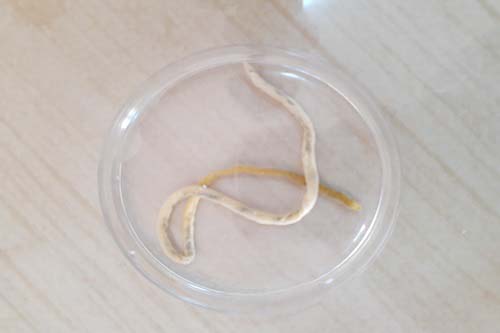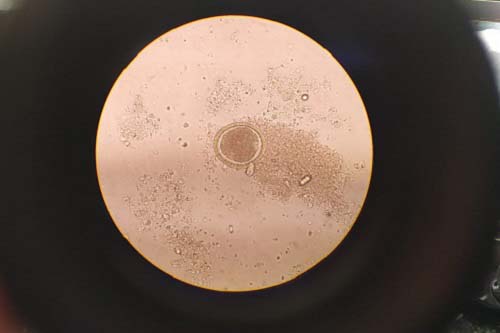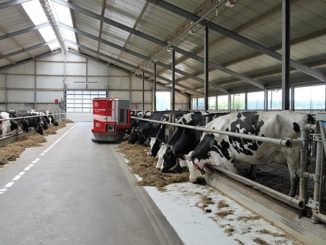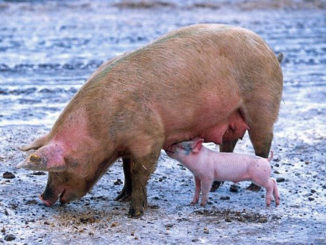Toxocara vitulorum a species of round worm parasite that infects Cattle, Buffalo and Bisons. The worm also called as Neoascaris vitulorum. Infestation is common in worldwide and more prevalent in America, Africa and Asia. Prevalence is more in tropical and sub tropical climates in Africa, Asia and America. This parasite belongs to the phylum Nematoda, class Secernentea, order Ascaridida and the family of Toxocaridae. Toxocara infestation is the primary cause to the mortality of the buffalo calves and severe economic losses to farmers. Toxocara vitulorum is a large round worm located in small intestine.Most commonly in Indian water buffaloes, more than 80 % calves will suffer with this parasite and high morbidity rate is observedand most of the immune suppression and unhealthy buffalo calves death occur due to the obstruction of small intestine, farmer traditional myth therapy, undiagnosed and untreated cases. Some reported that hot and humid climatic conditions were more prone for the Toxocara infestation.
Transmission
The T. Vitulotum usually present in the untreated adult buffalo and undergoes and arrested in the somotic tissues of cattle and buffalo. Once animal pasturated the parasite transmitted to the calves by intramammary route. The parasitic larva and egg ingested by the suckling buffalo calves. So the calves to which are 0-6 months old suckling calves are highly affected by this parasitic infestation. And both transplacental and transcolostral transmission is seen in Buffaloes. Major damage is caused by the larva migration in trachea, bronchioles, lung, liver kidney and mammary glands from which they finally reach to small intestine become adult and lay eggs. Feces of calves will be source of infection to other animalsmeans feco-oral transmission also occur in sometimes. Life cycle is direct without involving the intermediate host. Prepatent period will be 3 to 4 weeks in calves so calves with one months to 6 months will have higher incidence compared to other age group calves.
Zoonotic importance
Toxocara vitulorum has zoonotic importance. Human become infected by ingestion of infective eggs either from soil, contaminated hands, raw fruits and vegetable grown on infected buffalo calf faecal material and drinking of raw milk.
Morphological study of Toxocara vitulorum worm and egg
Large white round worm measures upto length of 30-40 cm, with 5-7 mm thickness. Female worms will be longer then male. Eggs were spherical measures 70-100 micro meter having double membrane with serrated borders having single cell inside.


Clinical observations of affected buffalo calves
In calves an adult worm are in the small intestine and competes for nutrition with the host. Affected calves will be dull, depressed, having rough hair coat, weakness, and pale mucus membrane, mud colored foul smelling faeces, diarrhea followed by constipation. Subnormal temperature, abnormal hair coat and bloat observed. Poor performance, steatorrhoea, intestinal and biliary obstruction followed by death. Some calves will show nervous symptoms and colic signs.

Diagnosis
- Based on history of animal showing symptoms like weakness, pot belly condition, and sometime parasite observe in the fecal material.
- Based on clinical signs and fecal sample collection for further confirmation of diagnosis.
- By faecal sample collected and thin smear made in the slide and examination under Compound microscope. Egg shows Spherical shaped double layered eggs with serrated border. Some times sedimentation process also help for detecting the parasitic egg. Sometimes adult worms will also are shed in the faeces. Mudcoloured foul smelling faeces going down condition are also indicators of Ascariasis in calves.
- Blood and serum sample collection for confirmation of haemoglobin and other parameters for the assessment of damage inside the body of the calves and also help in PCR for confirmation in species wise.
Treatment
Drug of choice is Piperazine salts (Both in slat and in liquid form) dosage at the rate 110 mg/kg Body weight of the calf. Albendazole can given at the dose rate of 5-10 mg/kg body weight. Fenbendazole given to calves and pregnant animals with the dose rate of 5-7.5mg/kg body weight. Pyrental salts @ 250 mg per calf will be given by per oral route. Oxfendazole given to the calves with the dose rate of 10-50 mg/kg body weight. Ivermectin oral or injectable preparations should be given to the calves more than 3 month of age at the dose rate of 0.2mg/kg body weight. Other anthelmintic drugs used under study purpose. Along with anthelmintic drug, supportive therapy should be used for early recovery of the calves. Such as zinc containing tonic and liver tonic for betterment of hair coat. When the anthelmintic drug given to the calves along with this sweet oil/ glycerin should be given orally for avoiding the small intestine obstruction due to death of parasite pushes in intestine and causes obstruction. Mineral mixture should be given to the calves for healthy growth.
Control measures
- Good hygienic practices in the farm.
- Pregnant adult animals should be dewormed with pregnancy safe deworming agents like Fenbendazole and Ivermectins at the calculated doses.
- Calves should be dewormed on 10th day, 20th day and 30th day followed by every month upto 6 months age, followed by every 3 months interval for one year. After one year of age deworming will be done on every 6months of period.
- Deworming of all animals in the farm on every 6 months of period.
- New animals brought in the farm should be dewormed and kept quarantine for 15 days for symptoms of any diseases.
- Proper disposal of manure and beddingmaterial.
- Providing clean drinking water to animals all time.
Reference
- Wikipedia
- Veterinary Medicine Notes By Dr Prasanna Kumar Veterinary College Bidar.







Good one
Good source
Nc information